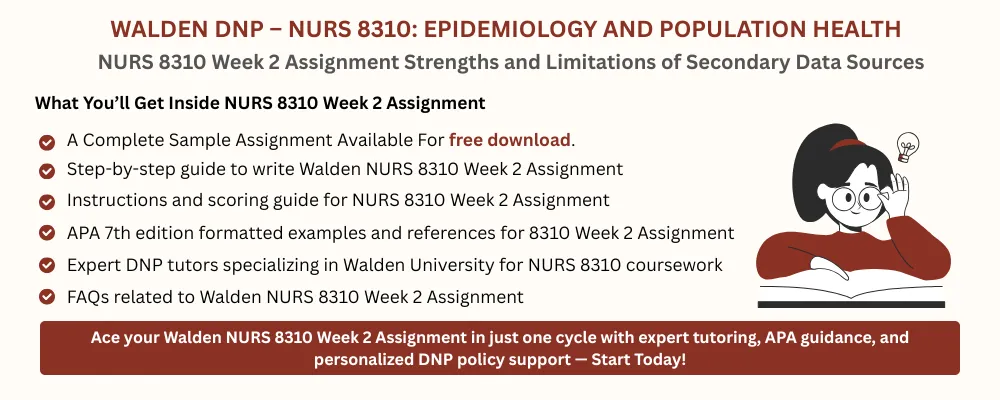NURS 8310 Week 2 Assignment FREE DOWNLOAD
NURS 8310 Week 2 Assignment
Strengths and Limitations of Secondary Data Sources
Student Name
Walden University
NURS-8310
Professor Name
Date
Strengths and Limitations of Secondary Data Sources
Population health is important in healthcare these days, especially for those trying to improve the health of many people. Problems of long-term disease, epidemic disease, and disparities in health services are still the major challenges. To handle these problems, decision-making and policy should mainly rely on data (Areco et al., 2021). Secondary data makes health investigations easy for the researchers as it does not require primary data collection by them. This assignment is intended to explain a prevalent population health problem and review three secondary sources of data. It will provide what it should consider when analyzing the association, verify the data sets’ reliability, and present the problems that one might face while using data from literature.
Identifying the Population Health Problem
The chosen population health problem is chronic lung disease, concentrating specifically on chronic obstructive pulmonary disease (COPD). The breathing difficulty of COPD is due to obstruction of the airways, typically as a result of long-term exposure to cigarette smoke and other noxious gases. For a lot of people, it kills, fills hospitals, and drives up healthcare costs. Elderly individuals and poor individuals are greatly affected in most instances. Public health researchers are worried about the disease (Villegas et al., 2021). Before making effective plans, there is a need to understand how common the condition is, what puts people at risk for it, and the problems in healthcare.
Identifying Relevant Variables
According to the level of relevance, reliability, and accessibility, three sources of secondary data were chosen to obtain the prevalence and the determining factors of COPD.
BRFSS
The Behavioral Risk Factor Surveillance System (BRFSS) is conducted by the Centers for Disease Control and Prevention (CDC) (Powers et al., 2024). BRFSS is one of the key sentinel health monitoring systems in the United States. The information is collected through annual surveys of residents of all the states (Powers et al., 2024). The BRFSS includes numerous questions about how people care for their health, any health problems they might have, and what steps they take to remain healthy.
GHO
The World Health Organization (WHO) is responsible for the Global Health Observatory (GHO). The GHO collects health data from dozens of countries and anchors it all in one place (Garmany & Terzic, 2024). It collects data on diseases in terms of how often people contract them, what causes them, and what health services are available, as well as the oral health of the population. GHO is now the primary resource to view COPD globally.
ICPSR
A wide range of social science and health topic areas are captured in the data archived by the Inter-University Consortium for Political and Social Research (ICPSR) (Bratt, 2023). Epidemiology utilizes cohort studies and cross-sectional studies to provide useful data on chronic diseases, risk factors, social status, the status of health care service, and availability. ICPSR adds value to in-depth research by including thorough documentation and data-info tools.
Assessing the Validity of Each Data Set
The selected datasets are believed to be reliable for studies in the public health sector.
CDC BRFSS
The CDC BRFSS is used in countless peer-reviewed papers and by policymakers who use the data from the CDC BRFSS. Instead, standardized questionnaires and a large sample size increase the reliability not just within the group, but also in terms of generalizability to the larger society (Powers et al., 2024).
WHO GHO
The WHO GHO sources its data from national health ministries and is based on internationally agreed-upon reporting standards (Garmany & Terzic, 2024). As a result, data is able to be validated, contrasted, and analyzed from global health trends.
ICPSR
While ICPSR data are not homogeneous, they are typically well-documented, peer-reviewed, and accompanied by metadata, meaning transparent (Bratt, 2023). A large number of ICPSR studies have been validated and published in high-impact-factor academic journals.
Such sources enable scientists to reach sound and robust conclusions about health.
Challenges in Using Secondary Data
Despite the numerous benefits, working with secondary data has its challenges:
- Secondary data may not be complete in terms of the variables that the researcher wanted (Baldwin et al., 2022). For example, an individual study may not have specific clinical measures of lung function or fail to report separate exposure data by region.
- Limited use special permissions or institutional access may apply to ICPSR. Data Collections may restrict or prohibit the use of these data for secondary analysis (Bratt, 2023). Availability of individual-level data may be limited due to ethical and privacy issues.
- Data that were collected at different times or places cannot be directly compared because the definitions, the ways of sampling, and the health care provided might have differed.
- People’s responses to BRFSS surveys could be influenced by recall bias or social desirability, leading to misreporting of smoking behaviors (Powers et al., 2024).
The recognition of these limitations is important in planning a study that truly addresses a health problem and does not generate false findings.
Conclusion
Reviewing population health, such as chronic lung disease, is characterized by secondary data analysis. Data from the CDC BRFSS, WHO GHO, and ICPSR can be used to examine how many people are suffering from a given disease, its causes, and effects. Some issues do arise, such as limited accessibility and variations in data quality, but then again, those things often can be managed with some foresight and careful analysis. In the era of rapid and low-cost health research, secondary data will be essential to shape public health responses, improve health outcomes, and increase scientific understanding.
Ace your NURS 8310 Week 4 Assignment with professional tutoring support on Epidemiologic Study Designs. Order assistance today!
Instructions To Write NURS 8310 Week 2 Assignment
Need instructions for this assessment? Contact us now and get expert guidance right away!
Instructions File For 8310 Week 2 Assignment
STRENGTHS AND LIMITATIONS OF SECONDARY DATA SOURCES
In this information age, where data are readily accessible and there is both a great demand for accelerated research projects and strict limitations on research funding, using existing data makes sense. Data used in this way are called secondary data; they come in many forms and contain information on just about anything—depending on who collected the information in the first place, and why.
As a health professional, you have access to a wide range of secondary data sources, including government agencies (such as the Census Bureau or the Centers for Disease Control and Prevention) and private sources, including local health service providers. Global and international data are available from familiar sources, such as the World Health Organization and the United Nations. In addition, nearly every nation maintains statistics on social, economic, and environmental indicators, which contain a wealth of health information as well.
As a member of the Walden community, you have access to the Inter-University Consortium for Political and Social Research (ICPSR), the world’s largest archival database of secondary data. You also have access to the Social Change Impact Report (SCIR) data sets – a Walden-owned database. There are a number of sources and tutorials available to you through Walden’s Office of Research and Doctoral Quality.
Though finding and accessing secondary data sources may seem time-consuming and tedious—because you can obtain “hard to find” existing secondary data sources related to the specific population health problem you are researching—the benefits are well worth the time involved in locating the source that you need to analyze to examine the association of interest and to assess the validity of the data source. For this Assignment, you delve into these issues in greater detail.
RESOURCES
Be sure to review the Learning Resources before completing this activity.
Click the weekly resources link to access the resources.
WEEKLY RESOURCES
TO PREPARE:
Consider a variety of population health problems and then select one of professional interest on which to focus for this Assignment.
Explore three data sources (data sets) presented in the Learning Resources that could aid you in describing the population and magnitude of the problem you selected. Consider the strengths and limitations of each data source.
THE ASSIGNMENT
In 3–4 pages (not including title page and references), analyze the data sources you selected by addressing the following:
Briefly identify the population health problem you selected.
Identify each data set you selected.
Identify the variables in each data set you would need to examine the association of interest.
Assess the validity of each data set. Has it been used for prior studies/publications?
Explain challenges you might face as a researcher in identifying a proper data set or securing permission to use it.
BY DAY 7 OF WEEK 2
Submit your Assignment.
SUBMISSION INFORMATION
Before submitting your final assignment, you can check your draft for authenticity. To check your draft, access the Turnitin Drafts from the Start Here area.
To submit your completed assignment, save your Assignment as WK2Assgn_LastName_FirstInitial
Then, click on Start Assignment near the top of the page.
Next, click on Upload File and select Submit Assignment for review.
NURS 8310 Week 2 Assignment Rubrics
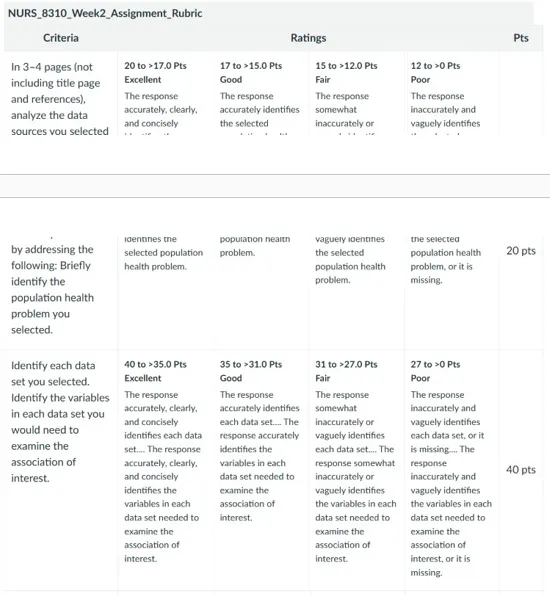
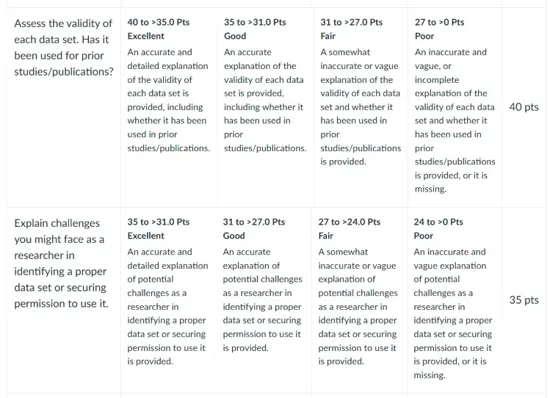
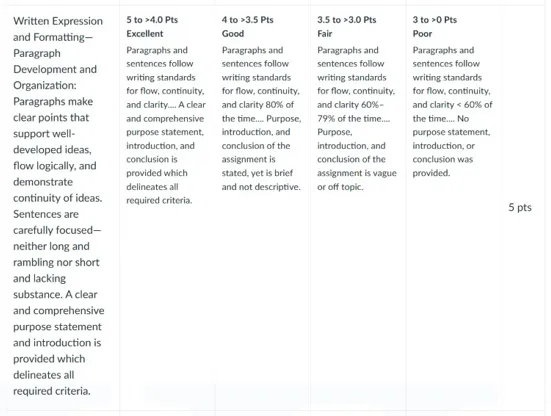
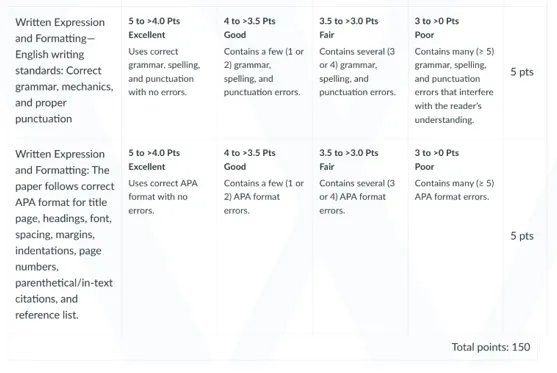
References For NURS 8310 Week 2 Assignment
Areco, K. N., Konstantyner, T., Paiva, P., Balda, R., Nobre, D. T., Sanudo, A., Kiffer, V., Kawakami, M. D., Miyoshi, M. H., Marinonio, A. S. S., Freitas, R., Morais, L., Teixeira, M., Waldvogel, B., Almeida, M., & Guinsburg, R. (2021). Operational challenges in the use of structured secondary data for health research. Frontiers in Public Health, 9, 642163. https://doi.org/10.3389/fpubh.2021.642163
Baldwin, J. R., Pingault, B., Schoeler, T., Sallis, H. M., & Munafò, M. R. (2022). Protecting against researcher bias in secondary data analysis: Challenges and potential solutions. European Journal of Epidemiology, 37(1), 1–10. https://doi.org/10.1007%2Fs10654-021-00839-0
Bratt, S. (2023). “Routine infrastructuring”: How social scientists appropriate resources to deposit qualitative data to ICPSR and implications for FAIR and CARE. Proceedings of the Association for Information Science and Technology, 60(1), 61–72. https://doi.org/10.1002/pra2.769
Garmany, A., & Terzic, A. (2024). Global healthspan-lifespan gaps among 183 World Health Organization member states. Journal of American Medical Association (JAMA) Network Open, 7(12), e2450241. https://doi.org/10.1001/jamanetworkopen.2024.50241
Powers, A. M., Patel, D., DeAngelis, M. M., Feng, C., & Allison, K. (2024). Risk factors affecting the utilization of eye care services were evaluated by the CDC’s Behavioral Risk Factor Surveillance System from 2018 to 2021. Frontiers in Public Health, 12, 1335427. https://doi.org/10.3389/fpubh.2024.1335427
Villegas, C., Zulueta, M., Montes, M., Bravo, P., & Pérez, M. (2021). Cost analysis of chronic obstructive pulmonary disease (COPD): A systematic review. Health Economics Review, 11(1), 1–12. https://doi.org/10.1186/s13561-021-00329-9
Best Professors To Choose From For 8310 Class
- Julia Bucher
- Sue Bell
- Marilyn Losty
- Cara Krulewitch
- Cheryl Holly
(FAQs) related to NURS 8310 Week 2 Assignment
Question 1: Where can I download a free sample for NURS 8310 Week 2 Assignment?
Answer 1: Download a free sample of NURS 8310 Week 2 Assignment – Strengths and Limitations from Tutors Academy with expert guidance.
Question 2: Where can I find the rubrics and instructions for NURS 8310 Week 2 Assignment?
Answer 2: Get the official rubrics and instructions for NURS 8310 Week 2 Assignment directly from Tutors Academy.
Question 3: What is the NURS 8310 Week 2 Assignment about?
Answer 3: It focuses on analyzing secondary data sources for population health studies like COPD with support from Tutors Academy.
Do you need a tutor to help with this paper for you with in 24 hours.
- 0% Plagiarised
- 0% AI
- Distinguish grades guarantee
- 24 hour delivery

